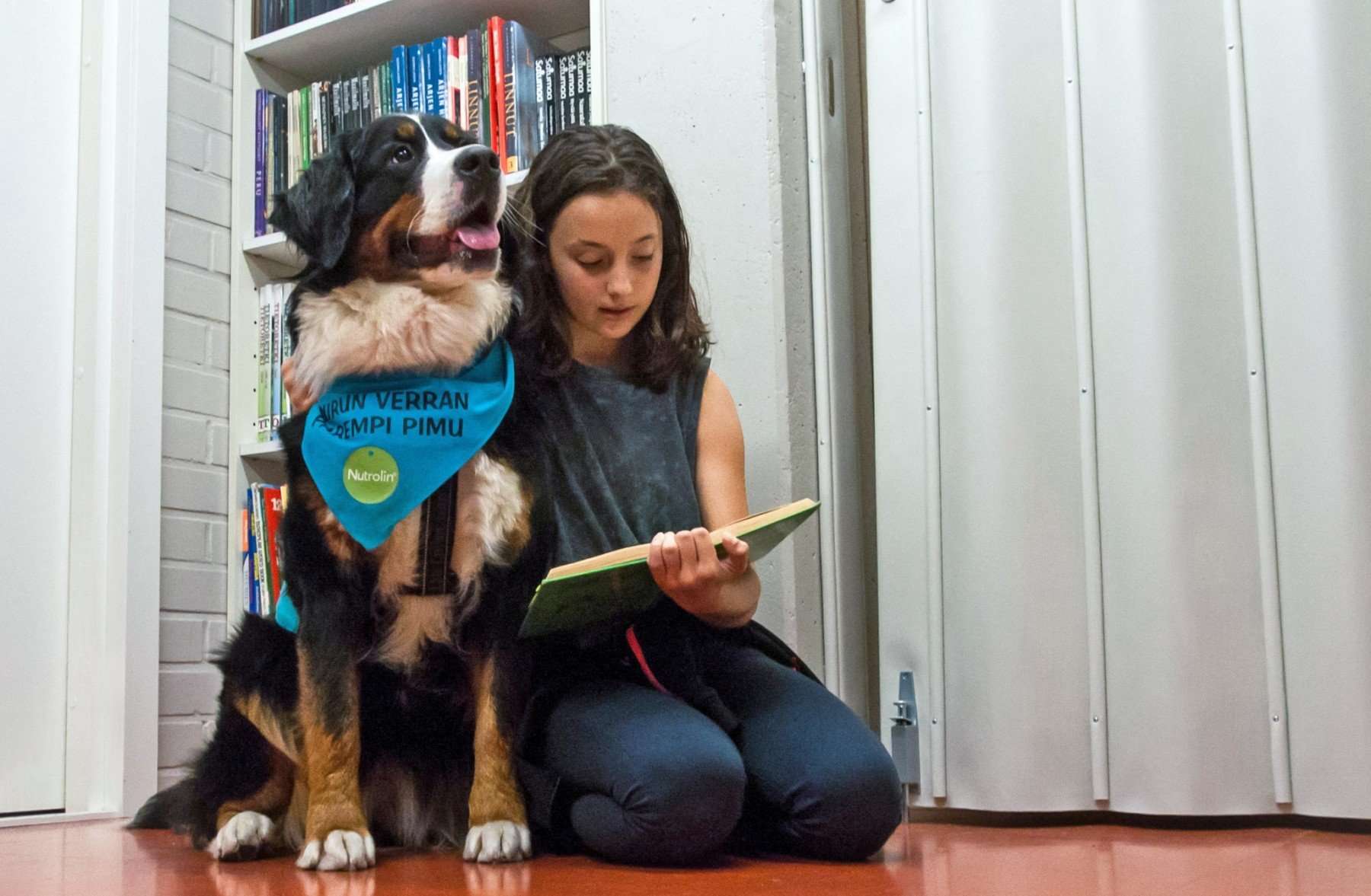Fifth-grader Donita is reading aloud from a children’s book while a Bernese mountain dog called Hilma-Maria listens attentively. When Donita scratches Hilma’s chin, the big dog’s eyes close blissfully.
Hilma is no ordinary dog – she’s a “reading dog,” on the job today at Hovirinta School in Kaarina, a town in southwestern Finland. Hilma’s mistress, Maarit Haapasaari, who is with her in the small classroom, started to use reading dogs in Kaarina in 2011, bringing the method to Finland for the first time.
Reading to a dog can be a highly rewarding experience for kids in need of reading practice. “The idea is to encourage children with reading difficulties to read aloud,” she says. “Dogs will listen contentedly to a child, not caring if the reader makes mistakes or only reads slowly.”
Kids who read to dogs experience a sense of fulfilment that boosts the children’s self-esteem and encourages them to pick up books more readily in future.
Reading dogs have also been used to help struggling readers in the other Nordic countries and in the US. The special feature of the system used in Finland is that during the activity only the dog, the child and the dog’s handler are present. “This makes the situation more intimate, so it’s easier for the child to read with no other listeners present,” says Haapasaari.
Inspired by the pioneering work done in Kaarina, many other localities around Finland have adopted the idea. Dozens of dogs today prick up their ears gratifyingly in response to young readers, though reading to dogs does not form part of the official school curriculum.
Heidi Puputti, who teaches a special needs class at Hovirinta School, reckons that reading to dogs particularly helps kids to relax and improves their ability to concentrate.
“Some children may normally be hyperactive in the classroom, but when they read to a dog, they calm down,” she says. “They understand that they are the ones in control of the situation, and that they must consider the needs of the listener. They also learn to be empathic and interactive. And when they read carefully, they notice that they can actually read quite well after all.”
A session with a reading dog typically lasts about five minutes, or up to 15 minutes for more advanced readers. The dogs visit the same schools many times, giving kids a chance to enjoy reading to them repeatedly.
Donita has also read stories to two other Bernese mountain dogs, called Viljo-Valdemar and Neiti Namu (Miss Cutie). “Viljo was really nice,” she says. “He listened very calmly.”
Bernese mountain dogs are particularly well suited to such tasks, due to their affectionate nature and cuddly appearance, though their large size also gives them a sense of dignity and authority. The breed of the dog is of little importance, though. All reading dogs start training as puppies to accustom them to different settings and people.
“We also keep in mind that some kids may be a bit afraid of dogs,” says Haapasaari. “The children can decide for themselves how close they want to be to the dog. The reading activity can also help children to overcome a fear of dogs.”
Canines and even cows encourage creativity
Haapasaari provides reading dogs for schools in southwestern Finland through her own business, called Hali-Koirat (Hug Dogs). In addition to being read to, her dogs visit old people’s homes and centres for people with disabilities, to be cuddled and stroked.
“Together with creative writing specialist Veera Vähämaa, we’ve also developed and registered a concept we call ‘Writing stories to tell to dogs,’” says Haapasaari. “Children write their own stories that they can then read aloud to a dog. This kind of activity isn’t practised anywhere else in the world yet.”
In the town of Raisio, not far from Kaarina, another business has set up a similar scheme, but the listeners are “reading cows.” Since it’s impractical to bring such listeners into schools and libraries, the kids also get to enjoy a visit to a farm.

SilasX on October 4th, 2017 at 19:23 UTC »
Yes, there are some programs to have children read to dogs to improve their self-confidence in reading and so it doesn't seem so scary. Dogs are very encouraging like that.
(Those who have too much confidence have to read to cats, I guess?)
Bertensgrad on October 4th, 2017 at 18:34 UTC »
I miss my grandparent having cattle they were always so cool and good to talk to as a kid. Feeding them apples got you on their good side. My favorite was a black and white face one with a white stripe down its middle. I used to call him Panda so wooly. I was so sad when they sold him.
Edit: photos of the panda gang.
https://imgur.com/gallery/Ju0ay
Panda, his cow friends, a picture of me on one of the days I went to visit him, i had to use a timer to do it, so it self shot for an assignment, and my grandpa.
All of the photographs were shot by me on a old minolta ssr so they not perfect. I developed the film and then printed the images Using a enlarger and dipping and drying them old school. You can see a fixer stain on my grandpas picture. The negative is good atleast.
I was wrong about the year hat he had panda it was the summer of 2003 and i was 15-16. So slightly more pathetic that I got that attached to the cow. Though I was hormonal then, and just lost my photography partner and straight crush in a car crash.
xoticpc-service on October 4th, 2017 at 17:56 UTC »
My kid's school does this with dogs. It is a great way to build up confidence in new readers as well